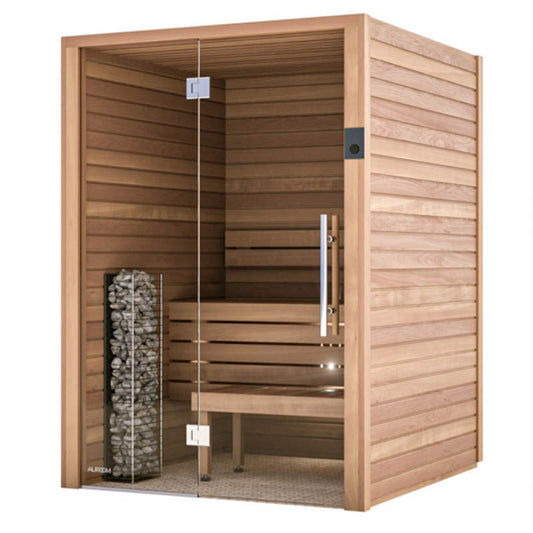The 5-Second Trick For Traditional Sauna
The 5-Second Trick For Traditional Sauna
Blog Article
The smart Trick of Traditional Sauna That Nobody is Discussing
Table of Contents5 Simple Techniques For Traditional SaunaThe 2-Minute Rule for Traditional SaunaThe 8-Second Trick For Traditional SaunaAn Unbiased View of Traditional SaunaTraditional Sauna - The Facts
Most of the weight lost in a sauna is water loss and is re-gained upon rehydrating. Nonetheless, undeniably sauna can be a crucial component of a healthy and balanced weight loss program. To take a look at the distinctions between typical and IR saunas, I will separate these into proven, theoretical, and produced differences.Thus, the hottest factor in the saunawhich is at the ceiling straight over the sauna heateris typically in between 185 and 190 F. Claims that a typical sauna exceeds 200 F is simply not true and not appropriate for electric saunas marketed in the United States. The temperature level for a far-infrared sauna is normally set between 120 and 140 F; however, unlike the traditional sauna, the objective in and IR space is not to accomplish a high temperature level.

When a standard sauna has actually been correctly heated, the sauna wall surfaces are cozy, the air temperature has achieved set temperature and the rocks are super warmed. As a fascinating side note, the heated wall surfaces and the rocks are discharging far-infrared warmth, incorporated with the warmed air, to develop an "wrapping up warm".
The Ultimate Guide To Traditional Sauna
When the heat is accomplished, the aspects cycle on and off to keep the heat. Many standard sauna individuals delight in putting water over the rocks to produce vapor to increase sauna moisture levels. The advantages of putting water over the rocks consist of: making the space more comfy, moistening the nasal flows, and allowing the usage of aromatherapy by blending crucial oils with the water.

When the energy gets in the body, it triggers the body temperature to raise and ultimately results in sweating. In an infrared sauna it is very important for the emitters/heaters to stay on almost frequently. Considering that there is no mass of rocks to preserve warm, the sauna will cool down if the emitters closed off.
Not known Details About Traditional Sauna
As discussed over, the sauna bather in an infrared space intends to place himself in front of operating emitters to obtain maximum advantage from the warmth. The heating time for both areas can be extremely various, relying on exactly how the rooms are made use of. For a traditional sauna, a bather should enable 30-40 mins for the space to achieve a preferred temperature level and to effectively pre-heat the rocks.

A well built sauna will usually accomplish a temperature level of 150-160 F in regarding 30-40 minutes. For hotter temperatures, the space may need to warmth for a longer duration.
To some, 15 mins was "squandered" while the infrared energy heated up the wood panels instead than heating a body, while others find a pre-heated area to be more comfy and believe an elevated beginning temperature is needed to begin perspiring. The size of recommended use for each and every space is roughly the very same (10-15 mins per session); nonetheless, as a result of the reduced air temperatures and the capability to feel the impacts of infrared heat faster than a conventional sauna, it is not unusual for an individual to invest a total of 20-30 mins in an infrared sauna.
Traditional Sauna for Dummies

The ordinary expense per kWH of electricity in the U.S. is roughly $0.11, so a 4.5 kW heater will set you back around $.50 to compete one hour, if the heating system runs continuously for one hour. Commonly a sauna heating system will certainly run for 75% of the initial hour and 50% of subsequent hours on considering that the aspects cycle once the established temperature is attained.
A 2 individual far-infrared room is generally physically smaller than a traditional sauna, usually about 4' x 4' or smaller sized. The IR furnace is commonly 1.5-1.7 kW making use of a 120 volt 15 amp plug-in solution. Since the area can be used faster than a sauna area, we will certainly think the space is made use of for to of an hour consisting of warm up time.
Ultimately, there is a seldom reviewed distinction in the social experience between the 2 spaces. While our society has shed some of the social benefit of the standard sauna experience, it can be really socially rewarding (Traditional Sauna). From household time in the sauna, to heart-felt discussions with better halves, to sauna partiesthe this article conventional sauna experience can cause intimate interacting socially
The 2-Minute Rule for Traditional Sauna
Many greater end infrared areas include tinted light treatment, audio systems and full-glass fronts.
Report this page